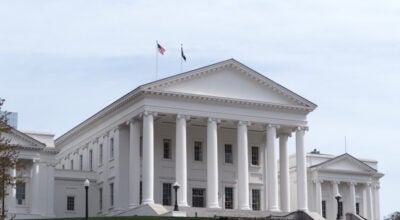Supreme Court adopts state redistricting maps
Published 5:18 pm Tuesday, January 4, 2022
IW, Surry shift Democratic under new boundaries
Isle of Wight and Surry counties presently form a strong Republican House of Delegates district, but will shift significantly toward Democrats under a final redistricting plan the Supreme Court of Virginia approved on Dec. 28.
The state Supreme Court had released draft voting district maps on Dec. 8 drawn by court-appointed special masters Bernard Grofman and Sean Trende after a bipartisan committee of legislators and citizens deadlocked in October on how to redraw the state’s Senate, House and congressional districts.
The present-day 64th District, which includes Isle of Wight, Surry and Prince George counties, and part of the city of Suffolk, is nearly 70% white and has consistently elected Republicans since 2011, when redistricting last occurred. Per federal and state constitutional requirements, state legislature and congressional voting districts must be redrawn once every 10 years based on the latest census data.
Under the new map, Isle of Wight will be split between new 83rd and 84th House of Delegates districts. The 83rd — which will include the town of Smithfield, all of Southampton, Sussex, Greensville and Brunswick counties, the city of Emporia and part of Dinwiddie County — will remain majority-white but include a much higher percentage of minority voters, and could go Democratic or Republican by a margin of up to five percentage points based on an analysis by the Virginia Public Access Project of votes cast in the 2016 presidential election.
A Dec. 27 memorandum by the special masters has the 83rd leaning between 3 to 5 percentage points in favor of Republicans based on votes cast during the 2017 Virginia attorney general and lieutenant governor elections.
The 83rd would encompass much of the same territory as the present-day 75th District, which Republican Otto Wachsmann won with 52% of the vote in November, unseating longtime Democratic incumbent Roslyn Tyler.
Republican Del. Emily Brewer, who won reelection in November with roughly two-thirds of the vote in the current 64th District, will now reside in the new 84th District — encompassing the town of Windsor, parts of Suffolk and all of the city of Franklin. The 84th will be nearly evenly split between white and Black voters, and is expected to swing five to 20 percentage points in favor of Democratic candidates based on VPAP’s analysis. The special masters’ memo also lists the 84th as likely to swing Democratic.
Surry will be in the new 82nd District, which now also includes parts of Prince George County, the city of Petersburg and the remaining areas of Dinwiddie County. It will become a majority-minority district, with whites accounting for roughly 45-46% of the population, and likely favor Democratic candidates by a margin of five to 20 points, according to VPAP’s and the special masters’ analyses.
According to VPAP’s analysis, the map gives House Democrats a slight edge statewide, reducing the number of solidly “red” Republican seats and “purple” districts that could swing either way.
A congressional battleground
Isle of Wight will also become more competitive in the 2022 congressional midterms under the new maps, which move the county out of U.S. Rep. Bobby Scott’s 3rd District, a safe Democratic seat, to the 2nd District, which Democratic Rep. Elaine Luria won with 52% of the vote in 2020. Under its new boundaries, the 2nd District will encompass the Eastern Shore, all of Virginia Beach, part of Chesapeake, all of Suffolk, Isle of Wight and Franklin, and part of Southampton County.
The special masters’ analysis of congressional elections spanning 2016 through 2020 shows the district leaning Democratic by a slim margin. However, VPAP’s analysis has the district leaning Republican by five to 20 percentage points based solely on its share of the votes from the 2016 presidential election.
Surry County would remain in the 4th District, which would also include all of Prince George, Sussex, Greensville, Brunswick, Dinwiddie and Charles City counties, as well as the cities of Hopewell, Petersburg, Emporia and Richmond, and parts of Southampton, Henrico and Chesterfield counties. The district is currently represented by Democratic U.S. Rep. A. Donald McEachin.
The newly redrawn 4th District will have a slightly higher percentage of Black voters than it does currently. The special masters’ memo and VPAP’s analysis both show the district remaining solidly “blue,” with Democratic candidates likely to secure roughly two-thirds of the vote.
Luria herself, however, will be displaced from the 2nd District, her Norfolk residence now located in Scott’s district, according to an analysis by VPAP. As a result, the newly redrawn 2nd District will be left without an incumbent member of Congress living within its borders.
A similar displacement of incumbents occurs in the 7th Congressional District, located in Virginia’s Piedmont region, and in the 9th District, which spans Virginia’s Kentucky and Tennessee borders — resulting in Democratic Rep. Abigail Spanberger and Republican Rep. Rob Wittman each living in the 1st District, and Republican Reps. Ben Cline and Morgan Griffith both residing in the redrawn 6th District.
Spanberger, who narrowly won reelection to the 7th Congressional District in 2020, would likely find reelection difficult given that the 1st is expected to swing Republican by a margin of five to 20 percentage points based on VPAP’s analysis.
Several Virginians had cautioned against moving Spanberger and Luria out of their districts during virtual public hearings on Dec. 15 and 17, citing a perceived bias. But the special masters’ Dec. 27 memo defends the move as necessary.
“While Democrats in recent years have been winning a majority of the statewide vote, as shown in 2021 it is still possible for Republicans to win in the Commonwealth,” the memo states. “Thus, a balanced map should give each party a realistic chance to control the congressional delegation and each of the branches of the legislature when that party has a good year, even if the overall partisanship of the Commonwealth makes it substantially easier for Democrats to do so in most years.”
IW, Surry lose Senate incumbents
No current state senators will live within the boundaries of Isle of Wight and Surry counties’ newly created Senate districts, according to an analysis by VPAP.
“Perhaps the most common criticism was that we paid insufficient attention to incumbency, weakened several congressional incumbents and paired together multiple senators and delegates,” the memo states.
In an earlier memo, Grofman and Trende argued they’d largely “maintained ignorance about the residences of incumbents” when releasing their then-draft maps on Dec. 8, since the federal and state statutory criteria for redistricting “make no mention of protecting incumbents.”
A total of 11 state Senate districts and 23 House of Delegates districts would be left without an incumbent legislator, according to VPAP, while in other cases, this lack of taking incumbency into account would result in two or even three legislators — some from opposite parties — all living within the boundaries of a proposed House or Senate district.
Isle of Wight is presently split among three Senate districts, two held by Republican Sens. Tommy Norment and John Cosgrove, and the third by Democratic Sen. L. Louise Lucas. Lucas and Norment also represent parts of Surry County.
Under the new map, Isle of Wight will move entirely into the 17th District, which now includes Suffolk, Franklin, Southampton County and part of Portsmouth. The district will be just over 50% white and is expected to lean five to 20 percentage points in favor of Democratic candidates based on VPAP’s analysis of its share of votes from the 2016 presidential election. The special masters’ memo also has the district leaning in favor of Democrats.
Surry will move to the 13th District, which will be majority-Black and will likely lean heavily in favor of Democratic candidates, according to VPAP’s analysis and the special masters’ memos.
Lucas, the state’s first African American and first female state Senate president pro tempore, is now placed into the same district as state Sen. Lionell Spruill Sr., another African American Democrat. Norment, likewise, has found himself paired with fellow Republican Sen. Ryan McDougle in the newly-redrawn 26th District.
According to the special masters’ updated Dec. 27 memo, the pairing of legislators is mostly due to reducing the number of instances where a municipality is divided between two or more voting districts. The previous congressional map had split 14 counties 16 times, while the previous General Assembly maps had split 46 counties 78 times to create Senate districts and had split 60 counties 138 times to create House of Delegates districts.
The new congressional map, by comparison, splits 10 counties a total of 11 times. The new Senate map splits 25 counties 34 times, and the new House of Delegates map splits 51 counties 98 times.
“Any redistricting map featuring this degree of geographic consolidation will almost certainly pair incumbents together … In this respect, we consider the treatment of incumbents to be an example of the redistricting process working as intended,” the Dec. 27 memo states.





